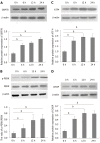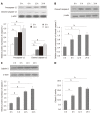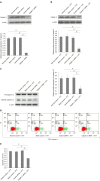Calpain-2 activity promotes aberrant endoplasmic reticulum stress-related apoptosis in hepatocytes
- PMID: 32308346
- PMCID: PMC7152521
- DOI: 10.3748/wjg.v26.i13.1450
Calpain-2 activity promotes aberrant endoplasmic reticulum stress-related apoptosis in hepatocytes
Abstract
Background: Calpain-2 is a Ca2+-dependent cysteine protease, and high calpain-2 activity can enhance apoptosis mediated by multiple triggers.
Aim: To investigate whether calpain-2 can modulate aberrant endoplasmic reticulum (ER) stress-related apoptosis in rat hepatocyte BRL-3A cells.
Methods: BRL-3A cells were treated with varying doses of dithiothreitol (DTT), and their viability and apoptosis were quantified by 3-[4, 5-dimethyl-2-thiazolyl]-2, 5-diphenyl-2-H-tetrazolium bromide and flow cytometry. The expression of ER stress- and apoptosis-related proteins was detected by Western blot analysis. The protease activity of calpain-2 was determined using a fluorescent substrate, N-succinyl-Leu-Leu-Val-Tyr-AMC. Intracellular Ca2+ content, and ER and calpain-2 co-localization were characterized by fluorescent microscopy. The impact of calpain-2 silencing by specific small interfering RNA on caspase-12 activation and apoptosis of BRL-3A cells was quantified.
Results: DTT exhibited dose-dependent cytotoxicity against BRL-3A cells and treatment with 2 mmol/L DTT triggered BRL-3A cell apoptosis. DTT treatment significantly upregulated 78 kDa glucose-regulated protein, activating transcription factor 4, C/EBP-homologous protein expression by >2-fold, and enhanced PRKR-like ER kinase phosphorylation, caspase-12 and caspase-3 cleavage in BRL-3A cells in a trend of time-dependence. DTT treatment also significantly increased intracellular Ca2+ content, calpain-2 expression, and activity by >2-fold in BRL-3A cells. Furthermore, immunofluorescence revealed that DTT treatment promoted the ER accumulation of calpain-2. Moreover, calpain-2 silencing to decrease calpain-2 expression by 85% significantly mitigated DTT-enhanced calpain-2 expression, caspase-12 cleavage, and apoptosis in BRL-3A cells.
Conclusion: The data indicated that Ca2+-dependent calpain-2 activity promoted the aberrant ER stress-related apoptosis of rat hepatocytes by activating caspase-12 in the ER.
Keywords: Apoptosis; Calcium; Calpain-2; Caspase-12; Endoplasmic reticulum stress; Hepatocyte.
©The Author(s) 2020. Published by Baishideng Publishing Group Inc. All rights reserved.
Conflict of interest statement
Conflict-of-interest statement: The authors declare no competing interests.
Figures






Similar articles
-
Family with sequence similarity 134 member B-mediated reticulophagy ameliorates hepatocyte apoptosis induced by dithiothreitol.World J Gastroenterol. 2022 Jun 21;28(23):2569-2581. doi: 10.3748/wjg.v28.i23.2569. World J Gastroenterol. 2022. PMID: 35949353 Free PMC article.
-
[Dithiothreitol promotes apoptosis in rat hepatocytes by inhibiting family with sequence similarity 134 member B (FAM134B)-mediated endoplasmic reticulophagy].Xi Bao Yu Fen Zi Mian Yi Xue Za Zhi. 2022 Dec;38(12):1104-1110. Xi Bao Yu Fen Zi Mian Yi Xue Za Zhi. 2022. PMID: 36585233 Chinese.
-
Yinchenhao decoction attenuates obstructive jaundice-induced liver injury and hepatocyte apoptosis by suppressing protein kinase RNA-like endoplasmic reticulum kinase-induced pathway.World J Gastroenterol. 2019 Nov 7;25(41):6205-6221. doi: 10.3748/wjg.v25.i41.6205. World J Gastroenterol. 2019. PMID: 31749592 Free PMC article.
-
Endoplasmic reticulum stress-induced hepatic stellate cell apoptosis through calcium-mediated JNK/P38 MAPK and Calpain/Caspase-12 pathways.Mol Cell Biochem. 2014 Sep;394(1-2):1-12. doi: 10.1007/s11010-014-2073-8. Epub 2014 Jun 25. Mol Cell Biochem. 2014. PMID: 24961950
-
Calpain: The regulatory point of cardiovascular and cerebrovascular diseases.Biomed Pharmacother. 2024 Oct;179:117272. doi: 10.1016/j.biopha.2024.117272. Epub 2024 Aug 18. Biomed Pharmacother. 2024. PMID: 39153432 Review.
Cited by
-
Family with sequence similarity 134 member B-mediated reticulophagy ameliorates hepatocyte apoptosis induced by dithiothreitol.World J Gastroenterol. 2022 Jun 21;28(23):2569-2581. doi: 10.3748/wjg.v28.i23.2569. World J Gastroenterol. 2022. PMID: 35949353 Free PMC article.
-
Calpain inhibitor MDL28170 alleviates cerebral ischemia‑reperfusion injury by suppressing inflammation and autophagy in a rat model of cardiac arrest.Exp Ther Med. 2023 Mar 17;25(5):196. doi: 10.3892/etm.2023.11895. eCollection 2023 May. Exp Ther Med. 2023. PMID: 37090078 Free PMC article.
-
Feedback loop between hepatocyte nuclear factor 1α and endoplasmic reticulum stress mitigates liver injury by downregulating hepatocyte apoptosis.Sci Rep. 2022 Jul 8;12(1):11602. doi: 10.1038/s41598-022-15846-8. Sci Rep. 2022. PMID: 35804081 Free PMC article.
-
Therapeutic effects of quercetin in oral cancer therapy: a systematic review of preclinical evidence focused on oxidative damage, apoptosis and anti-metastasis.Cancer Cell Int. 2025 Feb 24;25(1):66. doi: 10.1186/s12935-025-03694-1. Cancer Cell Int. 2025. PMID: 39994659 Free PMC article. Review.
-
Calpain-2 Facilitates Autophagic/Lysosomal Defects and Apoptosis in ARPE-19 Cells and Rats Induced by Exosomes from RPE Cells under NaIO3 Stimulation.Oxid Med Cell Longev. 2023 Jan 17;2023:3310621. doi: 10.1155/2023/3310621. eCollection 2023. Oxid Med Cell Longev. 2023. PMID: 36703913 Free PMC article.
References
MeSH terms
Substances
LinkOut - more resources
Full Text Sources
Research Materials
Miscellaneous

